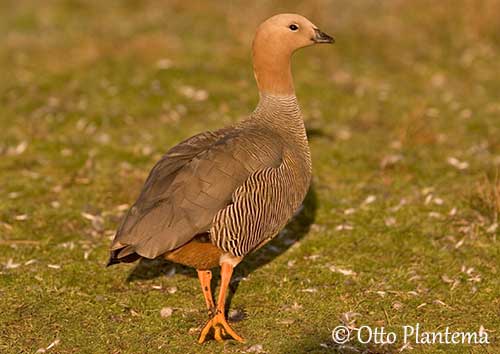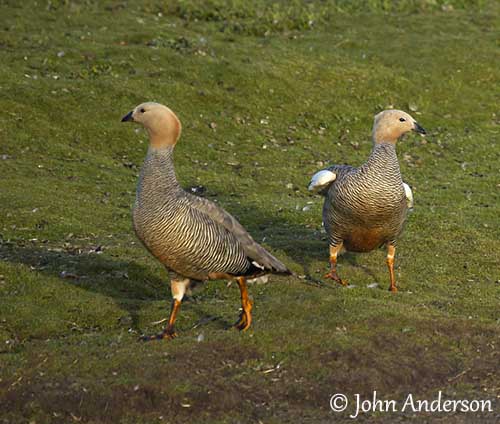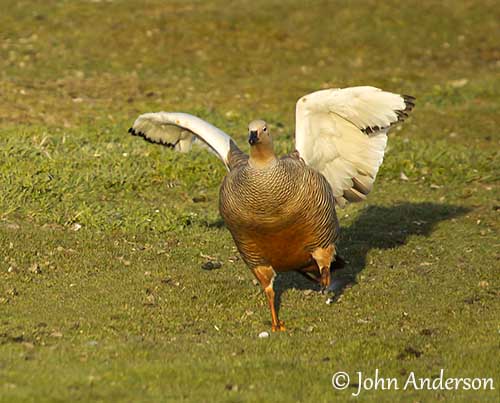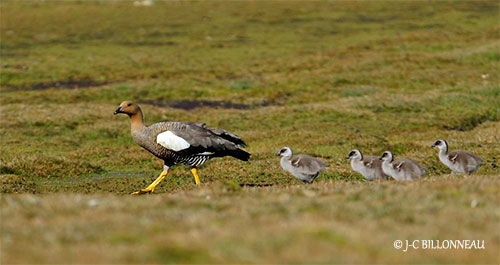
Fr: Ouette à tête rousse
All: Rotkopfgans
Esp: Cauquén Colorado
Ita: Oca testarugginosa
Nd: Roodkopgans
Sd: Rödhuvad gås
Photographers:
John Anderson
John Anderson Photo Galleries
Jean-Claude Billonneau
Photographe-témoin de la Beauté du Monde
Otto Plantema
Trips around the world
Text by Nicole Bouglouan
Sources:
HANDBOOK OF THE BIRDS OF THE WORLD vol 1 by Josep del Hoyo-Andrew Elliot-Jordi Sargatal - Lynx Edicions - ISBN: 8487334105
GUIDE DES CANARDS, DES OIES ET DES CYGNES – de Steve Madge - Delachaux et Niestlé - ISBN: 2603013769
BirdLife International (BirdLife International)
Protecting the wildlife of the Falkland Islands
Ruddy-headed Goose
Chloephaga rubidiceps
Anseriformes Order – Anatidae Family
INTRODUCTION:
The Ruddy-headed Goose has two populations, one in the Falkland Islands, and the other in southernmost South America, in Tierra del Fuego and Chile. The latter suffered large declines due to hunting pressure and predation by the Patagonian Grey Fox (Lycalopex griseus). These geese are rare today in South America.
However, the Falkland’s population is stable and this goose is common in the islands where it breeds and is resident.
DESCRIPTION OF THE BIRD:
Biometrics:
Length: 45-52 cm
Weight: 2000 gr
The adult has reddish-brown head and neck. The body plumage is grey and buff, finely barred brown.
The upperparts are mainly dull brown. Lower back, rump, uppertail-coverts and tail are black. On the upperwing, the coverts are white, but the greater coverts are black with bronze-green sheen. The secondaries are white and the primaries are black. The scapular feathers are finely barred black and cinnamon at tip.
On the underparts, belly and vent are bright cinnamon. The underwing is white with blackish primaries.
Outside the breeding season, head and neck fade to grey-brown.
The bill is black. The eyes are dark brown with white crescent above and below the eye. Legs and webbed feet are yellow-orange with black markings on the fore tarsus.
The female is similar but slightly smaller than male.
The juvenile is duller than adults, with blackish or grey speculum.

RANGE:
The Ruddy-headed Goose is found in the southernmost part of South America, in Tierra del Fuego and Chile where it was formerly more widespread. This population moves N to winter in Buenos Aires province, Argentina.
The Falkland’s population is sedentary.
HABITAT:
The Ruddy-headed Goose frequents grasslands and coastal meadows in open country. It can be seen in cultivated areas, foraging for food, and in freshwater marshes too.
In Falkland Islands, it occurs in coastal, drier meadows and open grasslands.
CALLS AND SONGS: SOUNDS BY XENO-CANTO
The Ruddy-headed Goose male utters short whistles “seep” whereas the female produces rasping quack.
BEHAVIOUR IN THE WILD:
The Ruddy-headed Goose is vegetarian and feeds on leaves, roots, stems and seed-heads of grasses and sedges. During winter, it feeds mainly in cultivated areas and stubbles.
It feeds by grazing and digging with its bill. It forages mainly on land and rarely in water.
The Ruddy-headed Goose is gregarious and can be seen in flocks (only in Falkland Is) outside the breeding season, often mixed with Upland Goose and Ashy-headed Goose.
However, it becomes very aggressive when breeding. The adults can attack larger birds entering their territory. Territorial fights may occur, during which males can be injured and even killed.
The mated pairs have long-term pair-bonds and usually pair up for life. They are monogamous.

The continental population of extreme South America migrates N in winter and reaches grasslands, pastures and cultivated areas of S Buenos Aires Province. The flight is powerful and sustained with continuous rapid wingbeats.
In Falkland Islands, this species is sedentary and only performs short internal movements. But it is often reluctant to take flight.
REPRODUCTION OF THIS SPECIES:
The breeding season starts between September and November in Falkland Islands, and the peak laying occurs in mid-October on the continent.
The Ruddy-headed Goose nests in single pair or in loose groups. The nest is built among the vegetation on the ground. It is usually hidden among tall grasses, bush or below overhanging rock. Occasionally, this species may use an abandoned burrow of Magellanic Penguin. The nest is made with grasses and soft vegetation, and lined with down.

The female lays 3-8 creamy-white eggs, and incubates alone during about one month. She is guarded by the male during this period. At hatching, the chicks have dark and pale grey down, black bill and legs. They remain about 15 hours in the nest where they are brooded to dry their plumage. Then, they leave the nest definitively and reach the water and the nearest feeding areas. They are able to feed themselves immediately.
PROTECTION / THREATS / STATUS:
The Ruddy-headed Goose suffered heavy persecution leading to important declines in South American population. In addition, the Patagonian Grey Fox is a nest predator. The mainland population was nearly extinct.
They are still threatened by hunting for sport and chemical poisoning from agriculture.
In Falkland Islands, the population is estimated at about 35,000/60,000 individuals and appears stable.
In spite of decline in the South American population, the Ruddy-headed Goose is currently evaluated as Least Concern.
